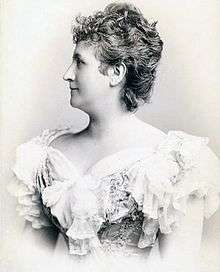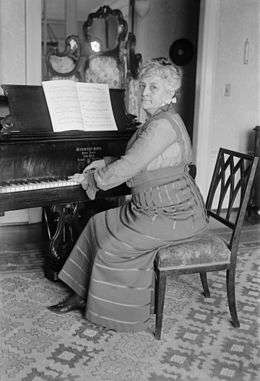Teresa Carreño
| Teresa Carreño | |
|---|---|
 | |
| Born |
December 22, 1853 Caracas, Venezuela |
| Died |
June 12, 1917 (aged 63) New York City, U.S. |

María Teresa Carreño García de Sena (December 22, 1853 – June 12, 1917) was a Venezuelan pianist, singer, composer, and conductor.[1]
Biography
Born into a musical family, Carreño's talent was recognized at an early age. She was at first taught by her father, Manuel Antonio Carreño. In 1862 her family emigrated to New York City. The young girl took a handful of lessons from Louis Moreau Gottschalk.[2] That year, she made her debut at Irving Hall at the age of 8. In 1863 Carreño performed for Abraham Lincoln at the White House.
In 1866 Carreño moved to Europe. She had lessons from Georges Mathias (a pupil of Frédéric Chopin) and from Anton Rubinstein. Carreño began touring, making her debut as an opera singer in 1876. She toured Australia at least once.[3] Franz Liszt offered her lessons, but she declined.[4] Carreño did not return to Venezuela until 1885, and then only for a short period. In 1889 she returned to Europe for more touring, settling in Berlin. Her performances earned the sobriquet,"Valkyrie of the Piano." She mounted two world tours in the early years of the twentieth century, but her health gradually deteriorated. She died on June 12, 1917 in her apartment in New York City.[1]
Legacy
She performed several times at Henry Wood's promenade concerts. He wrote: "It is difficult to express adequately what all musicians felt about this great woman who looked like a queen among pianists - and played like a goddess. The instant she walked onto the platform her steady dignity held her audience who watched with riveted attention while she arranged the long train she habitually wore. Her masculine vigour of tone and touch and her marvellous precision on executing octave passages carried everyone completely away."[5]
The Teresa Carreño Cultural Complex in Caracas is named after her, as is a crater on Venus. The Teresa Carreño Symphony Orchestra is a part of El Sistema.
Personal life
Teresa Carreño married three times and also had a common-law partnership with the brother of her final husband:
- 1873-1875 she was married to violinist Émile Sauret by whom she had a daughter, Emilita
- 1876-1891 she maintained a common-law union with Italian opera-singer Giovanni Tagliapietra, by whom she had two surviving children, Giovanni and Teresita (born 24 December 1882); the latter also became a famous pianist, under the name of Teresita Tagliapietra-Carreño
- 1892-1895 she was married to pianist Eugen d'Albert, himself oft-married, and together they produced two more daughters, Eugenia and Hertha
- 1902-1917 she was married to Arturo Tagliapietra, the brother of her former common-law husband Giovanni Tagliapietra.
Compositions
Teresa Carreño was also a composer. One of her first pieces was a waltz, the Gottschalk Waltzshe, published in 1863 and named after one of her piano teachers. She composed at least 40 works for piano, 2 for voice and piano, 2 for choir and orchestra include the Himno a Bolivar, 2 as chamber music and several merengues, incorporating the form as an interlude in some of her pieces (for example, in her piece entitled Un Bal en Rêve). She also left many incomplete works. She wrote a song called Tendeur, which was a "hit" in her time. On April 2, 1905, she recorded 18 pieces for the reproducing piano Welte-Mignon. Her daughter Teresita recorded in 1906 for Welte-Mignon as well.
See also
Notes
- 1 2 "Mme. Teresa Carreno, Famous Pianist, Dies. Artist, Who Also Had a Career in Opera, a Victim of Paralysis at 63". New York Times. June 13, 1917. Retrieved 2015-01-27.
Teresa Carreno most famous of women pianists, died last night at 7 o'clock in her home, 740 West End Avenue, after an illness of several months, which finally developed into paralysis. She was 63 years old, and was once the teacher of Edward MacDowell. ...
- ↑ "Teresa Carreno". La Musica Ilustrada Hispano-Americana. 1901. Retrieved 12 July 2015. Accessed via RIPM (subscription required).
- ↑ http://nla.gov.au/nla.news-article45810197
- ↑ Harold C. Schonberg, The Great Pianists, p. 328-29
- ↑ Sir Henry Wood, My Life of Music (1938), p. 147-148.
Further reading
- Kijas, Anna E. (2013). ""A suitable soloist for my piano concerto": Teresa Carreño as a promoter of Edvard Grieg's music". Notes: Quarterly Journal of the Music Library Association. Music Library Association. 70 (1): 37–58.
External links
| Wikimedia Commons has media related to Teresa Carreño. |
- Free scores by Maria Teresa Carreño at the International Music Score Library Project
- Audio extracts and sheet music on this dedicated page of the website gottschalk.fr
- Website dedicated to Teresa Carreño
- Piano Rolls (The Reproducing Piano Roll Foundation)
- Documenting Teresa Carreño
- North American Theatre Online(Alexander Street)